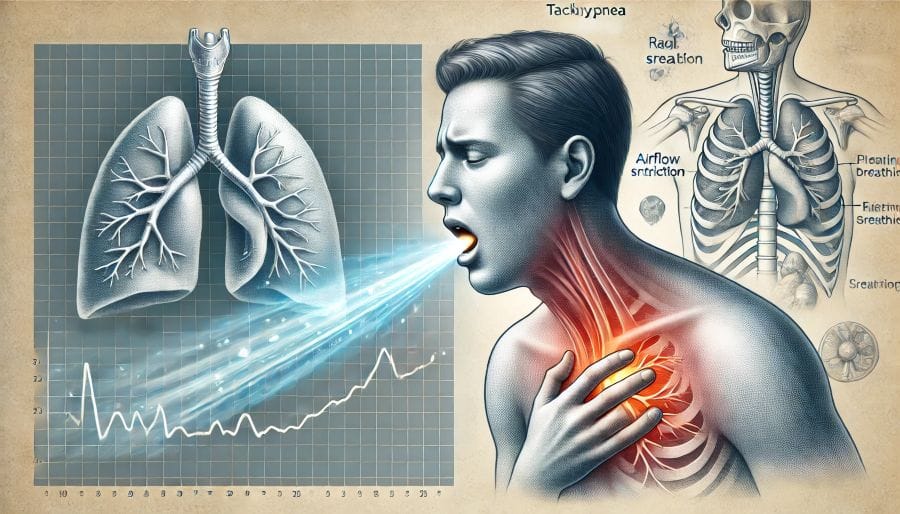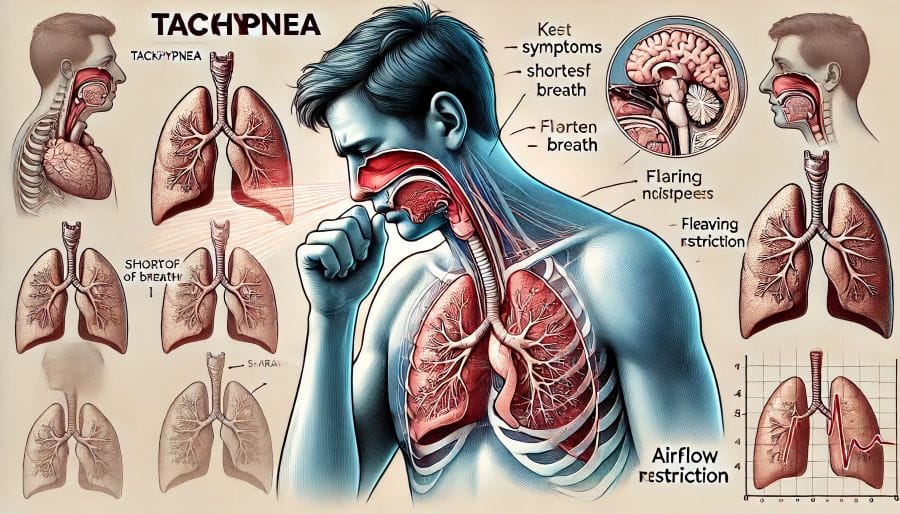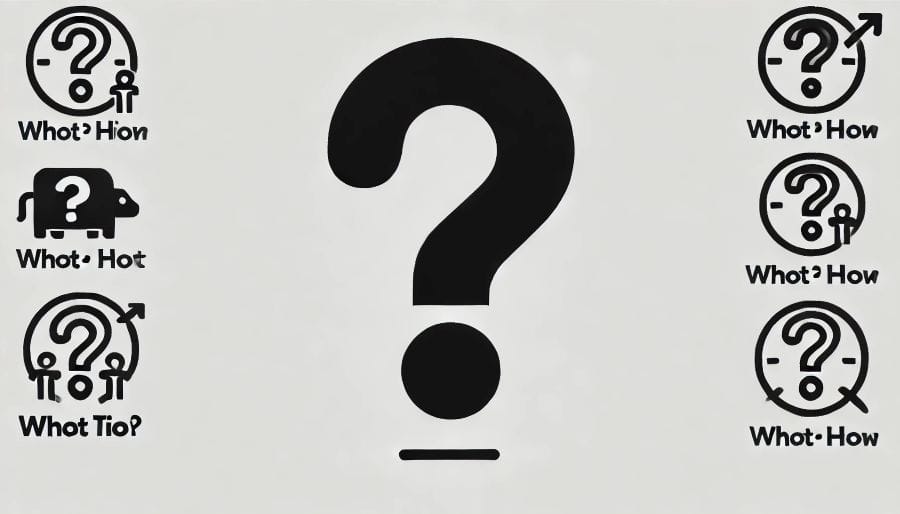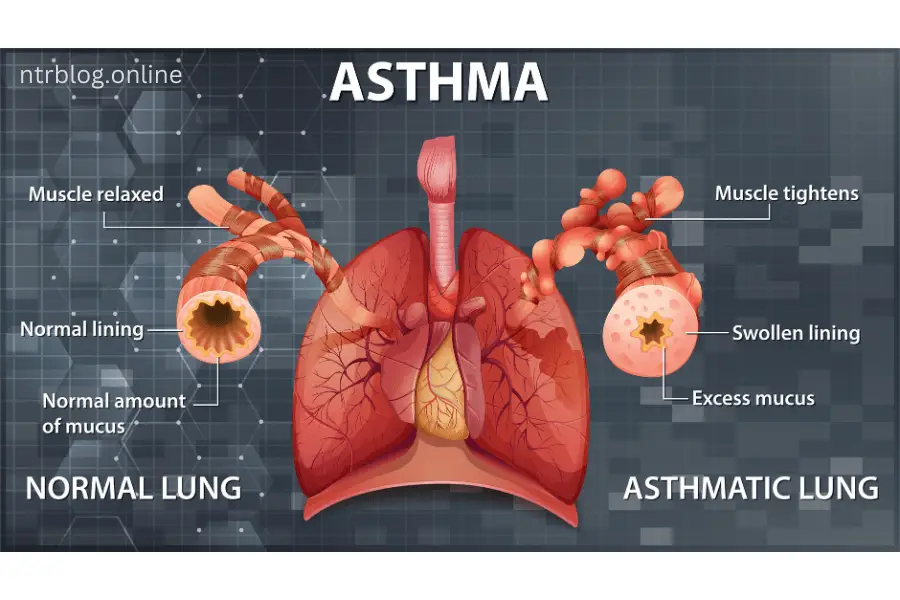Tachypnea is a condition where a person breathes at an unusually fast pace, often taking shallow breaths. This can create a sensation of breathlessness, making it feel like you’re not getting enough air. While it can affect anyone, it is particularly common in newborns and individuals with underlying respiratory conditions. Addressing the root cause is key to managing this symptom effectively.
Table of Contents
What is Tachypnea?
Tachypnea (pronounced tuh-KIP-nee-uh) refers to abnormally fast and shallow breathing. It can be a temporary occurrence or a sign of a more serious health condition. If your breathing rate suddenly increases and then returns to normal, it’s known as transient tachypnea. Several medical conditions, including lung diseases and infections, can trigger this rapid breathing pattern.
Newborns, especially those born prematurely, are most commonly affected by tachypnea. However, adults with conditions such as asthma, chronic obstructive pulmonary disease (COPD), or anxiety disorders can also experience it. While physical exertion like running or intense workouts naturally increases breathing rate, tachypnea occurs even when the body is at rest.

What Does Tachypnea Look and Feel Like?
Tachypnea can present with a range of noticeable symptoms, including:
✔ Bluish or grayish skin, nails, or lips – A sign that the body isn’t receiving enough oxygen.
✔ Chest pain – Discomfort or tightness in the chest while breathing.
✔ Shortness of breath – Feeling like you’re struggling to get enough air.
✔ Rapid, shallow breaths – Breathing quickly but inefficiently.
✔ Difficulty speaking – In severe cases, speaking in full sentences may become challenging.
⚠ When to Seek Emergency Help:
If you or your infant is experiencing severe breathing difficulty, bluish skin, or persistent chest pain, seek immediate medical attention. Call 911 or visit the nearest emergency room.
How to Check Your Breathing Rate at Home
If you’re unsure whether you’re breathing too fast, you can measure your respiratory rate by counting how many breaths you take in one minute. Here’s a quick guide:
✔ Normal Breathing Rate:
- Newborns: 40 to 60 breaths per minute.
- Adults: 12 to 25 breaths per minute at rest.
✔ Tachypnea Threshold:
- Newborns: More than 60 breaths per minute.
- Adults: More than 25 breaths per minute while at rest.
If your breathing rate consistently exceeds the normal range without an obvious cause (such as exercise), it could indicate an underlying issue that requires medical attention.
Final Thoughts
Tachypnea can be alarming, but understanding its causes and symptoms can help you take the right steps toward proper management. Whether it’s a temporary issue or a sign of an underlying condition, monitoring your breathing and seeking medical advice when necessary is essential. If you or a loved one experiences persistent rapid breathing, don’t ignore it—get checked by a healthcare professional.
Would you like me to add more sections, such as causes, diagnosis, or treatment options, to make the article even more comprehensive?
Possible Causes of Tachypnea
Tachypnea is not a standalone condition but rather a symptom that arises from various underlying health issues. Understanding the potential causes can help in identifying and addressing the root problem effectively.
What Are the Most Common Causes of Tachypnea?
Rapid, shallow breathing can result from numerous medical conditions, including:
- Allergic Reactions: Severe allergies can cause breathing difficulties as the airways become inflamed and narrow.
- Anxiety or Panic Disorder: Emotional distress often triggers hyperventilation, which mimics tachypnea.
- Asthma: This chronic respiratory condition leads to narrowed airways, making it difficult to breathe.
- Blood Clots: Clots in the lungs (pulmonary embolism) restrict airflow and oxygen exchange.
- Carbon Monoxide Poisoning: Exposure to this toxic gas reduces oxygen levels in the blood, triggering rapid breathing.
- Chronic Obstructive Pulmonary Disease (COPD): COPD obstructs airflow, causing labored and fast breathing.
- Diabetic Ketoacidosis: High blood sugar levels can result in acid buildup in the blood, leading to rapid breathing.
- Pleural Effusion: The accumulation of fluid around the lungs puts pressure on the respiratory system.
- Pneumonia: Lung infections can restrict airflow and oxygen exchange, leading to tachypnea.
- Pulmonary Embolism: Blocked blood flow to the lungs from a clot causes difficulty in breathing.
- Sepsis: This life-threatening infection can disrupt normal breathing patterns as the body fights off inflammation.
If you notice symptoms like tachypnea alongside any of these conditions, it’s essential to consult a healthcare provider for diagnosis and treatment.
Why Do Newborns Experience Tachypnea?
In newborns, tachypnea often stems from how their lungs adapt after birth. Here’s what happens:
Before birth, a baby’s lungs are filled with fluid to aid in development. During labor, hormonal changes prepare the lungs for breathing by encouraging the absorption of this fluid. The process involves the fluid being:
- Absorbed into the air sacs (alveoli).
- Released from the lungs during vaginal delivery.
If this fluid absorption occurs too slowly, the excess fluid can remain in the lungs, leading to a condition called transient tachypnea of the newborn (TTN).
This condition is more likely in:
- Babies born prematurely (before 37 weeks).
- Babies delivered via cesarean section, where fluid clearance may be less efficient.
While TTN typically resolves within a few days as the lungs fully adapt, it’s crucial to monitor your newborn for signs of breathing difficulty and seek medical care if needed.

Care and Treatment for Tachypnea
Tachypnea can be alarming, but the right treatment and care can help manage symptoms effectively. Whether it’s a temporary condition or a sign of an underlying issue, addressing the cause is key to recovery.
How Is Tachypnea Treated?
The treatment for tachypnea depends on its severity and underlying cause. Healthcare providers may recommend different approaches based on the patient’s age and condition.
Treatment for Infants and Young Children
For newborns and young children, medical intervention is often necessary to stabilize breathing. Common treatments include:
✔ Oxygen therapy – Oxygen is delivered through a mask or nasal tube to help regulate breathing.
✔ Supportive care – Monitoring in a hospital setting ensures the baby receives enough oxygen while the lungs adjust.
Treatment for Older Children and Adults
For mild cases of tachypnea in older children and adults, simple breathing exercises can help:
✔ Diaphragmatic breathing – Breathe deeply through your nose, allowing your stomach to expand, then exhale slowly through your mouth.
✔ Controlled breathing techniques – Slowing down your breathing can prevent hyperventilation and reduce anxiety-related tachypnea.
Emergency Treatments for Severe Cases
If tachypnea leads to significant breathing difficulties, immediate medical attention is necessary. Possible interventions include:
⚠ CPAP (Continuous Positive Airway Pressure) Machine – A device that delivers pressurized oxygen to keep airways open.
⚠ Ventilator Support – A machine assists breathing when the lungs struggle to function properly.
Treating the Underlying Cause
Since tachypnea is often a symptom of another condition, treating the root cause is crucial. Depending on the diagnosis, treatments may include:
✔ Medications:
- Antibiotics – To treat infections like pneumonia.
- Anticoagulants – To prevent or treat blood clots.
- Antihistamines – To reduce allergic reactions affecting breathing.
✔ Inhalers (Bronchodilators): Open up the airways for conditions like asthma and COPD.
✔ Cognitive Behavioral Therapy (CBT): Helps manage anxiety-induced tachypnea by controlling breathing patterns and stress levels.
How Long Does Tachypnea Last?
The duration of tachypnea varies based on its cause:
✔ Infants with transient tachypnea – Usually recover within 2 to 3 days as their lungs adjust.
✔ Older children and adults – Recover quickly once the underlying condition is treated.
⚠ Recurring tachypnea – If left untreated, tachypnea may return, especially in chronic conditions like asthma or anxiety disorders.
How Can Tachypnea Be Prevented?
While not all causes of tachypnea can be prevented, you can take steps to reduce the risk:
✔ Avoid allergens – Identify and stay away from triggers like dust, pollen, and pet dander.
✔ Exercise regularly – Strengthens lung capacity and endurance.
✔ Limit exposure to smoke and pollution – Stay in well-ventilated areas and avoid smoking.
✔ Install a carbon monoxide detector – Place one in your home and check the batteries every six months.
✔ Manage anxiety – Seek therapy or practice relaxation techniques to prevent hyperventilation.
✔ Treat underlying conditions – Regularly monitor and manage chronic diseases like asthma, COPD, or diabetes.
Final Thoughts
Tachypnea can be a temporary response to an illness or a sign of a more serious condition. The key to recovery is understanding the cause and seeking timely treatment. Whether through simple breathing exercises or medical intervention, managing tachypnea effectively can improve overall respiratory health.

When to Call the Doctor for Tachypnea
While occasional rapid breathing may not always be a cause for concern, certain symptoms accompanying tachypnea warrant immediate medical attention. Knowing when to seek help can prevent complications and ensure timely treatment.
When Should Tachypnea Be Treated by a Healthcare Provider?
It’s important to contact a healthcare provider if you experience any signs of tachypnea. In some cases, the condition may indicate an underlying medical issue that requires professional care.
When to Visit the Emergency Room
Seek medical help immediately if you or someone you know experiences the following:
⚠ Chest pain – Discomfort or tightness in the chest could signal a serious problem like a pulmonary embolism or heart condition.
⚠ Difficulty breathing – Struggling to catch your breath is a red flag that requires urgent evaluation.
⚠ Unexplained rapid breathing – A sudden increase in breathing rate without a clear cause may indicate a medical emergency.
⚠ Blue or gray skin, nails, or lips – These discolorations suggest low oxygen levels in the blood, which can be life-threatening if not addressed.
Why Is It Important to Treat Tachypnea?
Most cases of tachypnea are not life-threatening, especially if caused by temporary conditions like anxiety or exercise. However, persistent tachypnea can deprive your body of the oxygen it needs to function properly. Without enough oxygen:
- Brain function may be impaired, leading to confusion or dizziness.
- Heart health can be affected, as the heart works harder to circulate oxygen-deprived blood.
- Vital organs may suffer long-term damage if oxygen levels remain low.
Final Advice
If you or your loved one experiences symptoms of tachypnea, don’t hesitate to consult a healthcare provider. Early detection and treatment can prevent complications and ensure a faster recovery. In emergencies, such as severe breathing difficulty or bluish skin, call 911 or go to the nearest emergency room immediately.
Summary and Tips for Monitoring Tachypnea at Home
Quick Summary
Tachypnea, or rapid shallow breathing, can be a temporary symptom or a sign of an underlying health condition. While not all cases are life-threatening, it’s essential to know when to seek medical help, especially if symptoms like chest pain, difficulty breathing, or bluish skin occur. Treating the root cause is crucial to preventing complications and ensuring proper oxygen flow throughout the body.
Tips for Monitoring Tachypnea at Home
- Check Breathing Rate:
- Count how many breaths you or your loved one takes per minute.
- Normal ranges:
- Infants: 40–60 breaths per minute.
- Adults: 12–25 breaths per minute at rest.
- Watch for Warning Signs:
- Look for chest movements, skin discoloration (blue or gray), or signs of distress like flaring nostrils in infants.
- Practice Calm Breathing:
- Use diaphragmatic breathing techniques to slow down your breath if the rapid rate is anxiety-related.
- Maintain a Healthy Environment:
- Avoid smoke, allergens, or pollutants.
- Ensure proper ventilation in your living space.
- Prepare for Emergencies:
- Keep contact numbers for your healthcare provider and local emergency services handy.
- Install a carbon monoxide detector in your home to prevent silent respiratory risks.
By staying alert and proactive, you can manage mild cases effectively and identify when to seek professional care. Let me know if you’d like me to expand on any of these tips!


